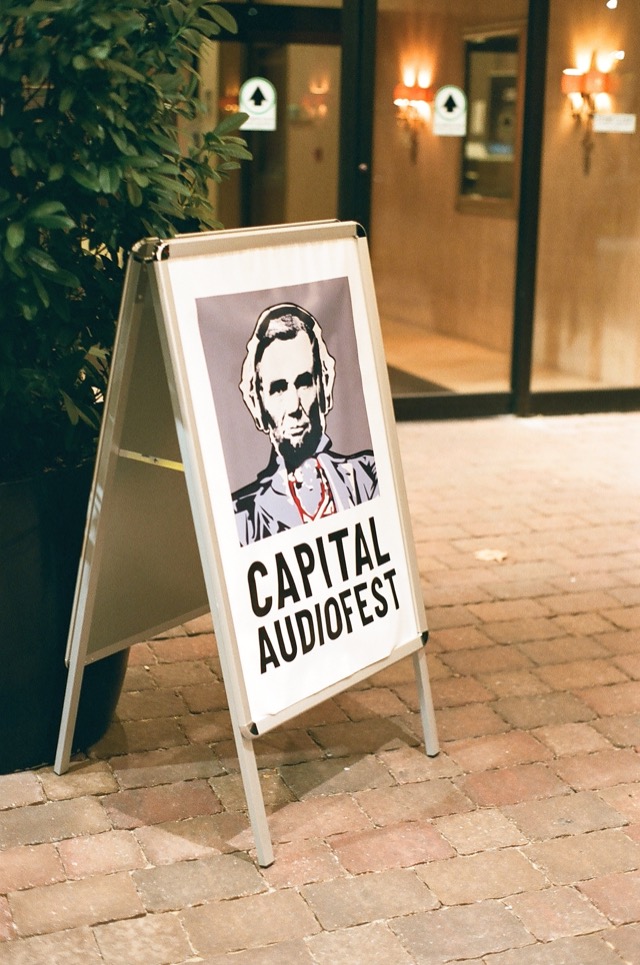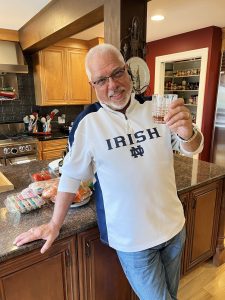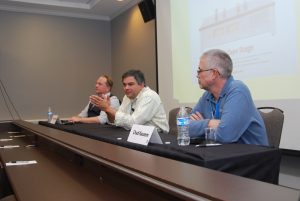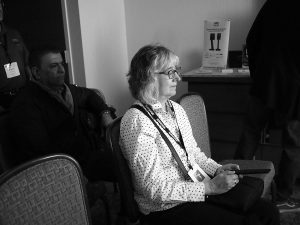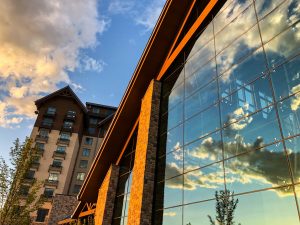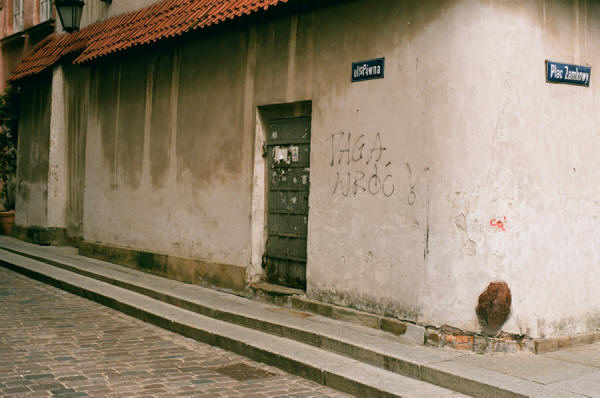
The European AES show is a very different beast than the American shows, in part because of much lower vendor involvement. The trade show section is very small, filling up only a section of a hotel ballroom rather than a whole convention center as with the US shows, and that puts more emphasis on the papers, workshops, and panels. It also means that it's possible to demo equipment and speak with people in a much more pleasant and relaxed fashion than in the US shows.
So, although I talk about a few products for sale in this review, the vast majority of this article is about workshops and papers, just like the conference itself, and there were some great ones.
Now, this is a "pro audio" show but there is emphasis especially in the European show at the top of the market and in high grade production work. And, of course, in the paper sessions there is new theoretical work going much of which applies equally to all sectors of the audio world. So, although this isn't the sort of thing you'd normally expect to see in a high end audio magazine, there is a lot of stuff here that people in the high end world ought to know about. That's why I always enjoy writing the show up for PF.
Loudspeakers
EVE Audio was showing off a line of speakers using the old Heil AMT tweeter in various configurations. Like the Heils, the top end was very sharp and etched and detailed without being perceptibly exaggerated, which is an interesting thing. These guys are out of Berlin and have had a presence at some of the earlier shows but it was good to hear their stuff under better conditions.
A local Polish company called Sveda Audio was showing a line of very clean-sounding and really quite reasonably-priced monitors. D'Appolito designs with Scan-Speak tweeters and active amplifiers. Very clean sound without being recessed and I'd love to see these guys both make more of a showing in the home market and push more into the US market.
Genelec from Finland was showing a new large format monitor, their 1234 SAM system, which is the next step up in size and sound level from their single point 8351 speakers. I wasn't able to hear them with my own material because they weren't able to play CDs and I couldn't get my CD into a .wav file, but Genelec has a long tradition of good design.
They also have a automated room-correction system which actually does not seem to be stupid. It only attempts to correct for low frequency boundary effects where room correction can actually do some good, rather than just stupidly trying to make the curves look flat on paper like so many automated correction tools do. It doesn't try to boost to fix holes in room response, because that's a futile thing to do. It only does the sort of things that I might do if I were trying to get good low end in a bad room, but it can do it very quickly. A great tool for anyone monitoring in the field in improvised control booths or living rooms where the room treatment might be less than good. How well does it really work in a good room? That's a question that needs to be answered.
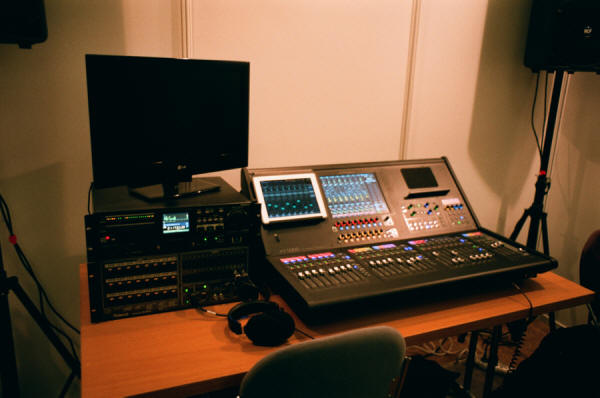
Kling and Freitag from Germany was showing some large PA speakers that looked impressive; there is very little PA gear shown at the US shows these days so it was good to see this there.
In Investigation of Current-Driven Loudspeakers, Henrik Schneider and others from the Technical University of Denmark gave a nice overview on research into loudspeaker damping effects. They built some good computer models to validate some of Hawksford's work back in the seventies and indicated some benefit to current-drive of speakers whose inductance varies with modulation. Preprint 9292.
Because loudspeakers have such high distortion, measurements of frequency response are often incorrect due to those distortion affects altering the measurement process. In Improvements in elimination of loudspeaker distortion in acoustic measurements), Finn Agerkvist and others describe an ingenious method for reducing that influence when measuring response.
Preprint 9316.
Niels Iverson and Arnold Knott, students at the TU Denmark, showed a switchable dummy load in Loudspeaker impedance emulator for multi-resonant systems. They built the device with lumped sum resistors, inductors, and capacitors, and switches to connect and disconnect them to model different speakers. Nothing innovative, but a useful tool. Preprint 9289.
Headphones
If you're listening through headphones, you're missing all of the acoustical effects provided by your earlobes, head, and shoulders, which all contribute to localization. If you want to hear accurate imaging through headphones instead of the traditional "hole in the middle" headphone sound when listening to conventional stereo recordings, you need some processing that can simulate those effects. The problem is, doing that is computationally intensive and difficult to do with a small portable device. In Functional Representation for Efficient Interpolation of Head Related Transfer Functions in Mobile Headphone Listening, Joseph Sinker and Jamie Angus (who did the actual presentation) describe some ingenious computational shortcuts to get good approximation of those effects with little CPU requirements. Preprint 9241.
Another headphone problem has to do with the interaction of the ear itself and the headphone, which means that if you actually measured the frequency response of the headphones on your ear, and the response of the same phones on someone else's ears, you would get different measurements just because of the shape of the ear and head. This makes taking isolated laboratory measurements of headphones very difficult. In Characterizing the Frequency Response of Headphones—a new Paradigm, Ulrich Horbach from Harman Advanced Technology Group compares several methods of measuring headphones on the bench and suggests a feedback device that permits compensation for the response of different heads so a given pair of headphones sounds as close to the same to different listeners as possible. Preprint 9274.
An interesting addition to a headphone system was described in Auto Panning In-ear monitors for live performers by Tom Webb and Andrew Horsburgh of Solent University in the UK. See, with the coming of PA systems, performers found it hard to hear one another the way the audience did, so stage monitors, wedges, and side fill speakers on stage came in to let them hear a good mix. But then stage levels got too loud, so in the past few years many performers have used earphones on stage. But with earphones, they lose a sense of space, so these media technology students took a Wii remote and used it for tracking the head positions, then automatically panned the sound sources in the headphones to match them so that sounds seem to come from the same direction as the performer's head moves around. Very cool and very useful. Preprint 9345.
In Assessing influence of a headphone type on individualized ear training, Sungyoung Kim from Rochester Institute of Technology and Sean Olive from Harman present Dave Moulton's ear training course (which I would like to highly recommend) to two groups of students over the course of a semester. One group uses standardized professional headphones, the other group whatever consumers headphones they personally own. At the end of the semester on a standardized equalization task test, the students using the professional headphones perform considerably better. This just goes to show that accuracy of reproduction can affect your ability to learn to listen. Preprint 9272.
Perceptual Listening
With a very different sort of ear training, in Effects of ear training on education on sound quality of digital audio for non-technical undergraduates, Akira Nishimura of the Tokyo University of Information Sciences gave some basic ear training to students that was specifically oriented toward hearing perceptual encoding artifacts in lossy compression, and found that after this training a larger number of students could hear such effects. This is very different than a general-purpose ear training program like described in the paper above, but it's also much less time-consuming if your goal is merely to teach identification of encoding artifacts. Preprint 9224.
In Audio Quality Moderates Localization Accuracy: Two Distinct Perceptual Effects, PerMagnus Lindborg and Nicholas Kwan determine that as MP3 compression rates decrease, perceived soundstage width decreases but also localization accuracy decreases (ie. the soundstage becomes narrower but also more diffuse). This shouldn't surprise anyone who has actually used MP3 compression but they did well to quantify the effect so now someone can correlate the listening test with the actual processes going on inside the encoder. Preprint 9313.
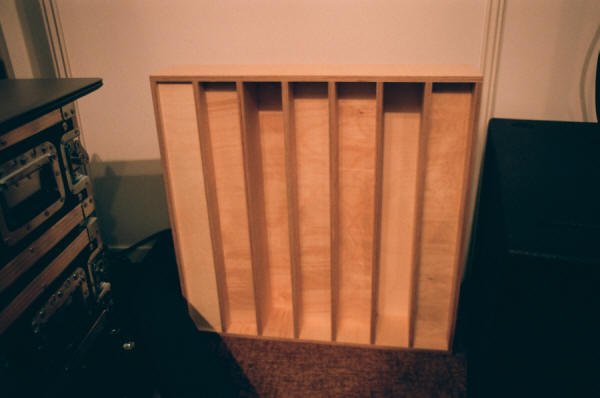
Acoustics
A number of local companies were selling acoustical products. Wave Acoustics, a division of the Ablo Group, is a Polish company selling a variety of solid well-made wooden diffusion devices and Helmholtz resonator panels. No relation to the US company of the same name, but they do some very fine work and thanks to the exchange rate they do it for very reasonable prices.
Gerriets from Germany was showing their Flex Acoustics system, with inflatable membrane absorbers for large halls that can be inflated or deflated to adjust the overall reverb time of the room for different sorts of performances. These folks also make some other absorber products and acoustical fabrics of high quality.
And, on the subject of variable acoustics, Winfried Lachenmayr and Gunter Engel from Mueller-BBM spoke on Comparing Room Acoustics for the Performance of Wagner's Lohengrin. This was a simple uncontrolled listening test between a recording made in the Festspielhaus Beyreuth (a room specifically created by Wagner for his operas) and a more conventional smaller German opera house. A listening panel found the dynamics very different, possibly due to changes in the orchestra but quite possibly in the way the orchestra and conductor hear the much larger room. They also felt the greater sense of space in the larger Festspielhaus made it easier for singers to be heard over the orchestra. This is more a back of the envelope sort of thing than a tightly conducted study but it was still very interesting because Wagner was really the first composer who attempted to control the entire production chain down to the audience's seat, and so he's the first conductor for whom we have an objective standard about what his work is intended to sound like in the hall. E-Brief 191.
In On the Development of a MATLAB-based Tool for Real-time Spatial Audio Rendering, Gabriel Moreno and others described a tool for rapidly setting up multichannel systems and trying out different algorithms for panning signals from sources to speakers. Again another took for investigating these many-speaker systems. Preprint 9243.
Juha Backman from Microsoft Mobility in Finland has long been doing studies on subwoofer effects in rooms. In Subwoofers in rooms: stereophonic reproduction he tackles stereo effects using a computer simulation of a room and a human torso, showing that although stereo subwoofers can cause amplitude differences between the two ears, room modes can dramatically affect this so that in a typical small listening room the actual stereophonic localization at low frequencies is necessarily poor even though in a larger room it may be better. (He didn't mention that control of low frequency rooom modes was the key to low frequency imaging accuracy but this can be inferred from this work.) Preprint 9319.
In Sound Radiation Control for Reducing the Effect of Strong Reflections, Jiho Chang and others from Samsung talked about a speaker array intended to be omnidirectional. But what if there is a wall behind it? He modeled the reflection from the wall in 3-space and then subtracted it from the wavefront being produced by the speaker array in order to help cancel out the wall reflection. By no means perfect, but still another step toward dealing with room reflections at low frequencies. Preprint 9259.
The Grand Theatre of the Narodowa Opera House in Warsaw was built in the 1820s, rebuilt after war damage in 1965, but always suffered from acoustical problems making it difficult for the performers to hear the orchestra and making for some difficult spots in the room. It also was too dead for some classic opera repertoire. In 2014, an active field control system was installed in the hall. This is a large array of microphones and speakers combined with digital processing intended to augment the hall acoustics in a fairly subtle way.
There have been other systems out there doing this, like the LARES from Meyer, but the AFC system designed by Yamaha is comparatively new and well regarded. It's not a PA system and the effect is designed not to be noticed.
Although I missed the tour of the facility itself, there were a number of papers on the subject. Takayuki Watanabe and others from Yamaha talked on Active Field Control in the Teatr Wielki—Opera Narodowa in an overview of the system that appears as Preprint 9330. Krzysztof Brawata and others from the AGH University of Science and Technology in Krakow evaluated the system subjectively with test subjects and ambisonic recordings made in the hall in Subjective Assessment of commercial sound enhancement system which was presented and available as Preprint 9306.
Another recent hall rebuild was discussed in the technology briefing, New Home for Polish National Radio Symphony Orchestra in Katowice by Piotr Kozlowski of Wroclaw University. This was in great part an exercise in seeing how low it was possible to make the noise level of a hall, with air conditioning systems in a separate building and ducted through large low-speed low-turbulence ducting to the main hall. Lighting systems, alarm devices, everything in the hall was tested for any tiny increase in the hall's noise floor. Another thing I found interesting was that the hall acoustics were not just simulated but were tested with scale models as was often done by Wallace Sabine and others of his era. This is a technique that has fallen out of use but which can provide great insights into a room. This was one of the more thorough design reviews of any acoustical design I have seen.
3-D Audio
With experimental work being done on next-generation audio formats employing large numbers of channels comes the need to building listening rooms and mixing theatres appropriate to them. The ITU has come out with a standard recommendation for rooms for doing such testing work (ITU BS.1116-2) and Sunil Bhatnagar at Dolby has been involved in building a room to meet that standard for listening to this material. In The Advanced Sound System Listening Room at Dolby, he describes the room and some of what went into interpreting the new standard. Preprint 9337.
Another thing that needs to happen with these new audio formats is that people really need to figure out how to mix in them. To that end, Will Howie from McGill University presented a paper by Bryan Martin, Brett Leonard, David Benson and himself, called Immersive Content in Three Dimensional Recording Techniques for Single Instruments in Popular Music in which they performed some listening tests with varying degrees of height information being added to playback of recordings of an acoustic guitar and have a panel evaluate subjective envelopment. Unsurprisingly, they find that there is such a thing as too much height information as well as too little, but exactly where the right point is becomes interesting. Preprint 9251.
Of course, a lot of minimalist recordings aren't made by mixing discrete sources with panpotted stereo, but are recorded with a microphone array that produces a direct representation of the sound source. How accurate such a representation can be made with a large multi-speaker array? In Natural Sound Recording of an Orchestra with Three-dimensional Sound, Kimio Hamasaki and Wilfried Van Baelen, the authors try various different microphone techniques to get hall ambience and height cues, then test them with a listening panel. There's no winner (any more than there would be with stereo miking techniques), but there is discussion of the differences. Preprint 9348.

Microphones
Josephson Engineering was showing off their line of high grade studio and recording microphones, including the C617 which I think is the most ingenious thing ever. This is a nickel-diaphragm measurement capsule, polarized at 200V, but with electronics that contain a DC-DC converter that allows it to be operated from an ordinary 48V phantom supply. It's not a new product, but it's a great product and it is a phenomenally clean but detailed omni. DPA has come out with something new, a vocal microphone using their existing 4000-series capsules. You can order it as an omni, cardioid, or hypercardioid, and you can order it as a a handheld mike or as a head that fits onto a number of standard wireless systems. These are very clean capsules combined with a well-designed blast filter for vocals and this "defacto" line looks worth checking out.
Loudholism
Avo-Rein Tereping from Talinn University in Estonia spoke on Preferred Sound Level for Concert Listeners and Correlations between Sound Quality Dimensions. He took a random listening group in a concert hall and played back a variety of recordings at different levels, in a random pattern. Then he asked them to evaluate the recordings on a variety of different scales (fidelity, loudness, spaciousness, overall clarity, and overall pleasantness) and broke it up by age group and gender. He found no significant differences between gender and age, surprisingly, but did find that people considered loudness an important part of 'overall pleasantness' and that people tended to prefer concert levels in the 85-87dBSPL range even over a wide variety of music. Which is surprising since so many concerts are so much louder than that (even big band and classical concerts at times). E-Brief 183.
There has recently been introduced a new ISO standard for measuring long-term loudness over the course of a program, the new BS-1770-3 standard and there was a large amount of discussion, several committee meetings and workshops, on applications of the new standard. The one I found most worthwhile though was Measuring and Analyzing Audio Levels in Film, Commercials and Movie Trailers Using Leq(A) values and the LUFS Loudness Model by Bozena Kostek, Kamila Milarska, and Aleksander Zakrzewski. These folks took a calibrated metering device into commercial movie theatres and measured program loudness over the course of commercials, trailers, and feature films, to find that most films were shown at safe loudness levels but commercials seldom were. Preprint 9336.
When all else fails, you can wear earplugs. But, most inexpensive earplugs aren't designed for flat frequency response. In The acoustic properties of different types of earplug used by sound engineers, Bartholomiej Kruk and Michal Luczynski from the Wroclaw University of Technology evaluate various earplugs both using a mechanical ear model and headphones, and using threshold tests on a listening group with and without earplugs. Unlike many AES papers they were not afraid to name names and it seems the Stopper ELA by Stanmark came out the best in their comparison. Preprint 9233.
Loud sounds cause the ear to shut down to protect itself, and the resulting temporary threshold shift is not uniform with frequency. This means that sustained listening at high levels causes a very distinct change in tonality which becomes a severe problem for sound reinforcement operators as well as studio mix engineers and musicians. In Perception of timbre changes vs. Temporary Threshold Shift, Bartlomiej Kruk and Maurycy Kin from the Wroclow University of Technology quantify this effect which is of great use to people determining listening level standards.
In addition to the papers there were a number of panels going on about loudness and loudness measurements. In The Loudness Wars: Give Peaks A Chance, Thomas Lund had a panel with Florian Carnerer and George Massenburg, talking about different measures of loudness and why they were important. One important point made here is that dynamic range isn't just one thing and talking about dynamic range can become confusing. Instead it's best to be specific about things like PLR, the peak loudness ratio, and specific measures of instantaneous and program loudness so that people can all mean the same thing when they talk. PLR was a new measure to me but a good one to describe peak to average ratios over a program; they have a subjective value of 11dB PLR to indicate the point where things sound clearly bad on a good speaker system. Having good measures that you can point at is a step toward showing when there is a problem and when there is not.
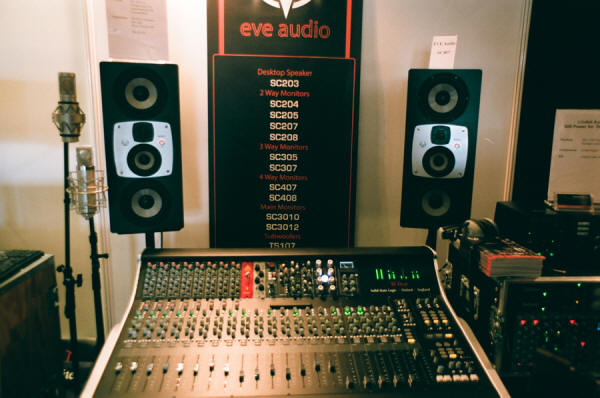
Listening
In Directional Bands Revisited, Rory Wallis and Hyunkook Lee spent a considerable amount of time doing careful listening tests using bandlimited noise on a group of test subjects to determine how localization effects are created by changes in the spectrum. Since some of how we localize sound depends on changes in response caused by our earlobes and head, recordings can simulate these cues or cause false cues and in the past detailed studies on exactly what effects caused what localization changes were lacking. This systematic study goes far toward helping to remedy that. Preprint 9278.
Long-term readers will know I am a huge advocate of matching listening tests and measurements, since each one is needed to understand what the other really means and they aren't useful in isolation. In Five aspects of maximizing objectivity from perceptual evaluations of loudspeakers: A literature study, Christer Colk, Soren Bech, Torben Pederson, and Flemming Christiansen review the existing literature on performing accurate listening tests and provide a good bibliography on recent work on experimental design for such tests. Preprint 9230.
I think there is often a philosophy that adding room reverberation on playback will increase the sense of listener envelopment where the listener feels like the recording is around him. However, in An investigation of the relationship between listener envelopment and room acoustic parameters—the influence of varied direct sound levels and onset times of late reverberation on listener envelopment, Mai Ishida and others from the Tokyo University of the Arts found exactly the opposite effect. Why? They found situations where increasing early reflections and decreasing later ones improved the sense of envelopment in a test listener group. Why? Clearly something interesting is going on here and more exploration is needed. Preprint 9309.
In Elicitation of the differences between real and reproduced audio, John Francombe and others from the University of Surry set up a pair of studios, one with a live band and the next with sound piped in from the first studio, then asked for descriptions from both experienced and inexperienced listeners about the differences they heard. A total of twenty-nine terms were used by the listeners to describe the differences, some of which aren't commonly used in the literature. Preprint 9307.
One of the more interesting studies at the show was Analogue Hearts, Digital Minds? An investigation into perceptions of the audio quality of vinyl. Michael Uwins presents a number of recordings to people either on vinyl or directly digitally, and determines that people who claim they prefer vinyl usually do not in the test. Unfortunately his test is flawed in a lot of ways; for example due to difficulties of cutting low end on disc the vinyl recording has altered frequency response compared with the digital playback. And, the vinyl recording has been digitized to make the playback easier, which some vinyl fans may claim eliminates whatever benefit the vinyl has. However, in spite of all the major holes in it this is still an interesting study and it's certainly worth revisiting this idea and doing more careful studies of the phenomenon to separate out the various different artifacts that the LP record/play chain may induce and see which ones of them may be considered beneficial and which ones (for example the lack of extended low end) may not. E-Brief 185.
On the other end of the phono spectrum was Reconstruction of Mechanically Recorded Audio Signals using White-Light Interferometry, by Khac Phuc Hung Thai and others who used an interferometer to profile Edison cylinders and then derive audio from them. The high end response was somewhat reduced due to the limited resolution of the interferometer but this may be another worthwhile new method for non-contact playback of old archival recordings. Preprint 9300.
Plug-ins
PSP was showing off their line of software plug-ins for digital workstations. I don't normally mention plug-in vendors in my show reviews, but that is because I normally don't even notice them. The PSP software is very commonly used... and although I didn't realize it, it's written in Poland! And, here at the European show it was possible to talk with the developers without standing in line.
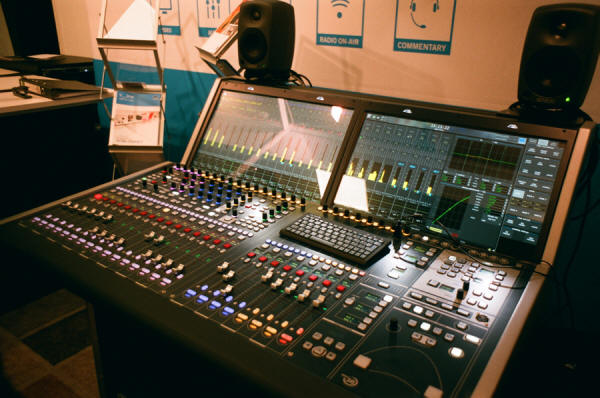
Consoles
There were a number of console vendors there, but I was very interested in Malcom Toft's new Trident 88 console. This is a traditional, modular, old style large format console, maybe a little cleaner sounding than the classic Tridents in a good way. A new preamp design, a new backplane design for very low noise, and your choice of direct or transformer-isolated inputs and outputs. Trident came back a few years ago selling a very nice entry-level console with their classic layouts and design, so now that they have re-established themselves a bit they are coming out with the sort of high quality gear that they were known for in years past. Well worth checking out if you're considering a big console (or even an 8-channel one... they can even shortload an 8-channel frame).
Roland was also selling a new digital mixing console called the OHRCA for Open High Resolution Configurable Architecture. It's seems in some ways like the traditional modular console brought into the digital world with the ability to swap different modules in and out to have different sorts of consoles on the same hardware platform. Intended for live sound, but of course to change it into a recording-style console would be only a software change.
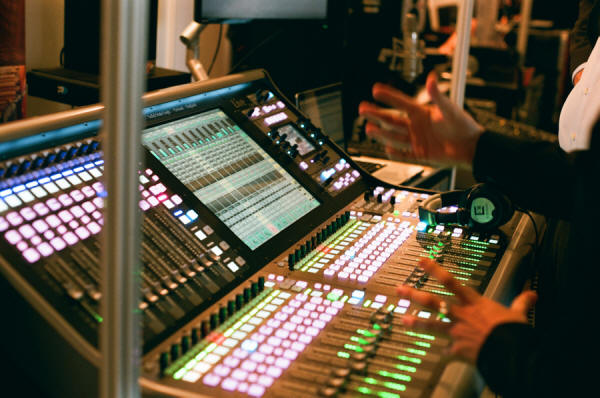
Electronics
Doug Self has been the great friend and great foe of the audiophile both, because he has gone out of his way in the past few decades to accurately quantify small effects and show that many of them can actually be heard, and that others cannot. If anyone has gone far to put some of the "common wisdom" of the high end community on actual scientific grounds, it has been him. This year he gave (at nine in the morning no less) an engineering brief called Progress in Power Amplifiers: Thermal Distortion in which he actually tracked down the source of dynamic changes in amplifier circuits as a result of thermal changes (which are dependent on signal). He goes through actual measurements to track slow changes dependent on high current resistances in the feedback loop. Absolutely worth reading for anyone interested in power amplifier design. E-Brief 192.
A number of papers have been coming out in recent years from various quarters about using gallium nitride high speed switching transistors for Class-D amplifiers. These are very high performance discrete power transistors that may have some use in providing a crisper and better defined switching transition for the power stages in these amplifiers in the interest of reducing distortion. In GaN Power Stage for Switch-mode Audio Amplification, Rasmus Ploug, Arnold Knott, and Soren Bang Poulsen discuss their experiences in building such a circuit and how it performed. Personally I think a lot more work needs to be done on class D amplifiers before they can be considered acceptable for high performance monitoring applications, and this study is one step toward getting there. Preprint 9273.
In How Green is my Amp?, Jamie Angus points out that although Class D amplifiers are much more efficient than linear amplifier designs at full power, at very low levels they may be less efficient, and in fact most amplifiers are used at a fraction of their maximum power most of the time. He did some evaluations with typical musical signals and came out with some numbers that make traditional linear designs look better than people may think. Preprint 9290.
Traditionally vacuum tube amplifiers were designed using graphical methods, back in the days when computation was difficult and expensive. Seely's Method Of Load Lines still has some advantages over modern computational methods as far as helping the designer understand what is going on with the circuit, and is still commonly used. In Simulation of parameters of tube audio circuits using web browsers, Grzegorz Makarewicz from the Warsaw Institute of Technology describes a simple javascript program to display prepared tube curves for various devices and allow the user to fit load lines to them. It's limited right now to triode and pentode models (no tetrodes with kinks for instance) but this method can actually be very useful for designing mosfet circuits as well. A very useful updating of classic design methods into the digital world. Preprint 9304.
On the way out, the plane began rocking in a lot of turbulence and the pilot came on the intercom to tell all the people returning to Poland to switch seats to the lefthand side of the aisle. Because, everyone knows that for stability you need the Poles on the lefthand side of the plane. This is an engineering joke. I won't explain it here because then it won't be funny.
Cable
Two great German manufacturers of high grade professional audio cables, Sommer Cable and Cordial Cable were showing there. Some very well-made cables (and the Europeans are very big on high flexibility... which for stage cables can translate into less mechanical noise conducted into the mike). Sadly, neither company seems to have US distribution... but European readers might want to check their products out.
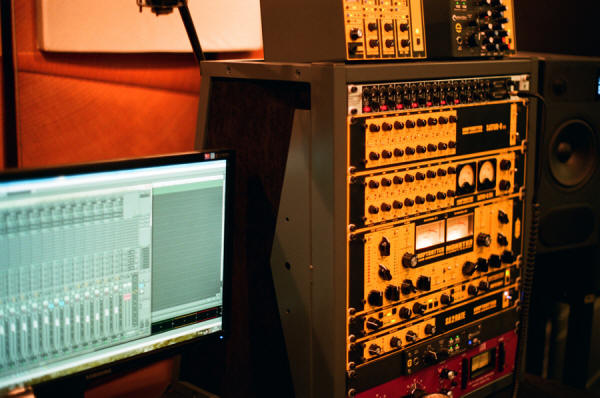
Processing Gadgets
DirectOut from Germany was showing a very handy little box called the EXBOX.UMA, which is a USB/MADI/ADAT translation box to integrate ADAT lightpipe gear into a MADI world but also to integrate MADI gear into a lightpipe world. And to connect them all to USB. Very handy!
A Polish company called Looptrotter was showing off a number of handy studio processors based on discrete circuitry, including a compressor, saturable limiter, general purpose dynamics processor. Nothing particularly unusual or new, but it's good to see people getting into the analogue processing world these days with a new name.
Another Polish company, SOS Audio Upgrades, was showing a preamp and compressor set that looked like it was worth checking out.
Converters
RME, a German company well-known in the US, was showing off a line of inexpensive but good-looking converters and preamplifiers.
There were some impressive high end converters from NTP Technology in Denmark, 24 channels in one 2U box with MADI , AES/EBU, and IP audio with both A/D and D/A in the same unit.
Prism was showing their ADA-8XR modular 8-channel D/A/A/D box which I had seen before but what I noticed this time is that they have native DSD inputs and outputs available for the thing. There is less and less DSD gear out there so it's very good to see that available. Prism is out of the UK and is one of the grand old companies from the early ages of the digital revolution.
In the papers sessions, Marcin Lewandowski from the Warsaw Institute of Technology was talking about modeling converters in a different way. In A short-term analysis of a digital sigma-delta modulator with nonstationary audio signals, he presents an interesting time-domain method of modeling errors and nonlinearities in modern sigma-delta converter designs. He doesn't actually go into details about practical use of the model but he goes into some real detail about the difficulties of estimating nonlinear modulation error in a system where the future behavior depends on the past. Preprint 9253.
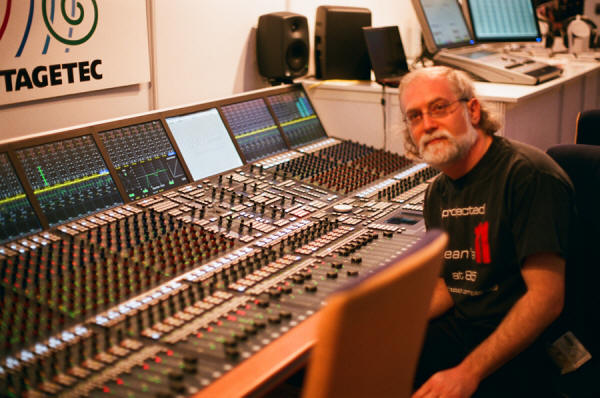
Production
Producing radio news, drama, and documentaries isn't like music production but yet the people doing it normally employ software and systems designed more for music production than their specific applications. In Use of audio editors in radio production, Chris Baume, Mark Plumblet, and Janko Calic investigate some of the methods used in BBC production with an eye toward future software optimization. Not detailed research here, but a good overview of what process and requirements really are. (Of course, being a study at the BBC the requirements may be quite different than in American radio where commercials, spots, and bumpers are a large part of the job of the production room). Preprint 9237.
In Radio Studio Acoustics, a two part paper, Ian Dash and Mark Bowry point out that radio production studios have different requirements than recording studios. They do some room evaluations and find that a method using multiple open microphones more realistically represents the situation in a normal broadcast studio, and recommend this method for testing. They find low reverb time at low frequencies is very important subjectively, as is constant reverberation with frequency above 125 cycles. Interestingly the panel prefers rooms with best timbre rather than best intelligibility. A very good introduction to some of the differences between radio and recording facility requirements. Preprint 9256 and 9257.
In H.G. Wells' futuristic novel The Sleeper Awakes, live performances can be watched on television with feedback so that the performers on stage can hear the audience applauding in their homes. In Evaluation of the low-delay coding of applause and hand-clapping sounds caused by music appreciation, Kazuhiko Kawahara and others from Kyushu University and NTT in Japan describe a system to do just that. They use a perceptual encoding system designed specifically just for applause sounds so the return channel data rate can be extremely low. No way to convey boos and hisses, though. Preprint 9225.
In Concept of Film Sound Restoration by Adapting to Contemporary Cinema Theatre, Johanna Napieralska from the Chopin University of Music discussed techniques for remixing film soundtracks of the seventies and eighties for presentation in modern theatres. No new science here, but a good discussion of the aesthetic considerations into updating old tracks without making them stand out or seem artificial, to still retain the original intent of the producers. Preprint 9339.
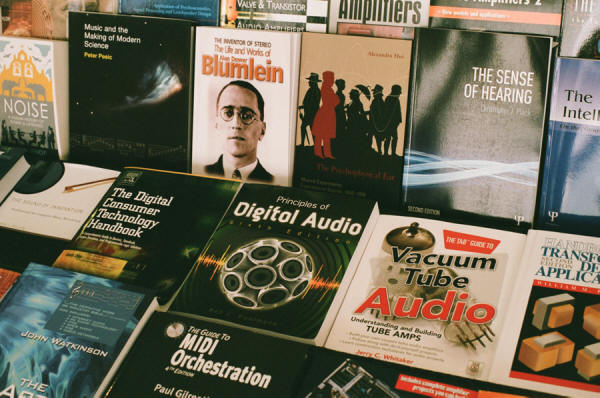
The Press
Not as many audio magazines were represented at the show as are at the big American shows. Zenon Schoepe from Resolution Magazine was there, and I would like to commend this magazine to the world at large for actually making real measurements of loudspeakers being reviewed and holding manufacturers up when the actual measurements don't live up to the numbers in the marketing glossies. Letting people know honestly about gear is one of the main functions of the audio press but one that too few take as seriously as Resolution.
Still, there were some new ones like the Polish Estrada Studio magazine, and the Journal of Applied Computer Science editors from Lodz.
Conclusion
The show was smaller and more intimate than the US shows, and for the most part I am thinking that is a good thing. A lot of people talked about new technology and a few people showed off some new hardware.








